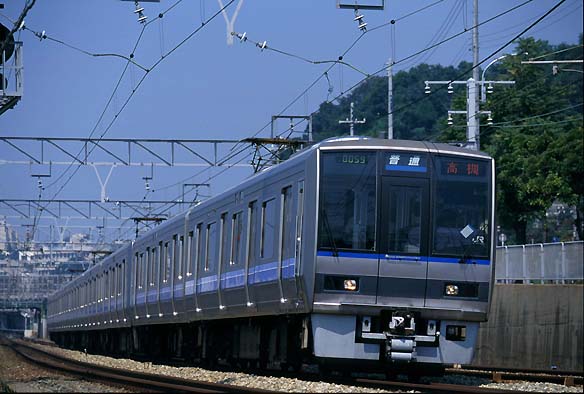Background and overview
207 series commuter DC electric multiple unit (EMU) trains delivered to
Takatsuki depot to replace superannuated 103 series EMU used on JR Kobe
and JR Kyoto lines in 1994 have some improvement and are classified into
-1000 subseries.
Their formation are 6-car sets consisting of a motored end car, two motored
intermediate cars, a trailer end car, and two trailer intermediate cars,
and 2-car sets consisting of a motored end car and a trailer end car. 207-1000
series introduced single unit system and motored end car, class kumoha207
in order to make flexible formation of 2-car set to 8-car set.
Bogies
Motored bogies are WDT55B and trailer bogies are WTR239B, featuring bolster-less
secondary air suspension, corn-shaped multilayered rubber spring journal
supporting system, and the Watts linkage draw gear. These bogies be prepared
to adopt the yaw dampers to ensure smooth ride characteristics even at
120km/h. Motored bogies employ single tread brake device adopting automatic
gap-adjusting unit, and trailer bogies employ both single disk brake device
and single tread brake device.
Traction unit and ancillary equipments
All motored cars are equipped with a variable frequency drive traction
system, WPC3A, featuring high frequency Gate Turn Off thyristor controls
four asynchronous traction motors, WMT102, with a power output of 200kW
on axle basis and an auxiliary power supply, WSC31, with a power output
of 140kVA featuring IGBT under their floor. They are also equipped with
a cross arm type current pickup, WPS27D, with the protection against heavy
snow, and prepared to be fitted with another current pickup on their roof.
Trailer end cars, class kuha206, and trailer intermediate cars, class saha207-1100,
are equipped with a motor driven air compressor, WMH3093-WTC2000A. They
feature the electric commanding brake with regenerative and holding brake,
featuring brake control of trailer priority.
Two air conditioners, WAU702B, rated at 21,000kcal/h/unit, are fitted on
their roof.
Additional delivery
Three 4-car sets and nine 3-car sets were additionally delivered to Miyahara
depot in 1995.
207-1000 series delivered to Yodogawa depot and Takatsuki in 1996 depot
differ from former 207-1000 series in having more powerful traction motors,
WMT104, with a power output of 220kW.
Additional twenty-eight 3-car sets were delivered to Takatsuki depot for the start of the operations on JR Tozai line.
Modification to be ready for opening JR Tozai line
Some of class moha207-1000 were remodeled to inserted 207-0 series 3-car
sets, removing current pickups and classified into -1500 subclass for the
start of services of the JR Tozai Line in 1997. Additional two class moha207-1000
vehicles were also built at this time. An additional current pickup was
fitted to every motored vehicle except class moha207-1500.
Operations
207-1000 series entered the revenue services on JR Kobe and JR Kyoto lines
in March, 1994. After the start of services pf the JR Tozai line, 207-1000
series had been used on JR Takarazuka and Gakken-Toshi lines rapid services
and JR Kobe, JR Kyoto, JR Takarazuka, JR Tozai and Gakken-Toshi lines commuter
services.
Modification and refurbishment
Their livery started to be changed into same scheme having dark blue and orange colour carried from 2nd generation commuter train, 321 series, in 2005.
The prominent anti-fall plates on the front ends of class kuha206-1000
vehicles used on 4-car sets and class kumoha207-1000 vehicles used on 3-car
sets were also began to be fitted from 2014.
From 2014, a refurbishment programme was commenced on 207-0 series. Their
body was reinforced against off centre and lateral collision. Body Vibration
Detector (BVD) detecting derailment, collision, and overturning to stop
the train urgently. High-Intensity discharge (HID) headlights and auxiliary
headlights were employed. LED destination indicators were replaced with
full coloured one displaying sequential vehicle number additionally. The
semiconductor elements of their traction system were changed into Insulated
Gate Bipolar Transistor (IGBT).
Passenger accommodation was also improved. Seven-seater longitudinal seating having 440mm seating width was changed into six-seater seating having 470mm seating width. Stanchions were additionally fitted at the both end and centre of seating. Their wind screen structure is enlarged. All end cars are equipped with wheelchair spaces. LED lighting was introduced to the passenger saloons.
LED meter panel of the driver's cab was changed into the analog indicators.
Latest operation status
207-1000 series are now used on JR Takarazuka, Gakken-Toshi, Oosaka-Higashi,
and Yamatoji lines' rapid services and JR Kobe, JR Kyoto, JR Takarazuka,
JR Tozai and Gakken-Toshi lines' commuter services. |
|





